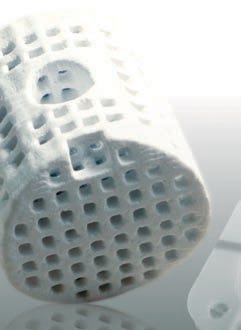November 30, 2010
|
The Fast Ceramic Production (FCP) process yields complex geometries for orthopedic implants that are not achievable by other ceramics manufacturing methods. |
During the past 25 years, medical-grade ceramics have enabled tremendous progress in the design and development of medical implants. But limitations in current ceramics manufacturing processes may have hampered the development of difficult-to-manufacture shapes and innovative parts. With its fast ceramic production (FCP) process, however, 3DCeram is looking to eliminate these restrictions by producing complex geometries that it claims are not achievable by other ceramic fabrication methods.
Drawing from additive manufacturing methods, FCP employs laser stereolithography (SLA) technology for the rapid manufacture and medium-volume production of ceramic parts from 3-D CAD files. "However, the difference between plastics prototyping and this technology is that we achieve what we call 'good material,' which means it has the required final ceramics material properties that are equal to those produced using ceramic injection molding or other traditional ceramics processes," explains Richard Gaignon, cochairman of 3DCeram.
Using laser SLA, the process entails building a component in successive layers by polymerizing a paste composed of photosensitive resins and a high load of ceramic powders such as hydroxyapatite, zirconia, or alumina. The part is then cleansed of excess resin, placed in a UV chamber for postcuring, and sintered to obtain the desired density, hardness, and other properties.
"With FCP, you are building the product layer by layer, which means you can produce designs that are impossible to produce by any other method, even by spending a lot of money," states JB Lafon, president of Euro Industries Inc., the U.S. sales representative of 3DCeram. "These are shapes that you just cannot produce with ceramic injection molding or machining." Furthermore, the process does not require the production of any tooling and can reduce manufacturing times--and thus overall costs--as well, Gaignon adds.
In addition to achieving complex geometries, FCP promotes osseointegration in ceramic implants by enabling controlled porosity. This capability yields more-wear-resistant ceramic components and, thus, less hazardous debris, according to Gaignon. "There are other processes where you can produce porous parts to promote bone growth with ceramics; but you can hardly control some key parameters," Lafon says. "With the FCP process, you can actually control the size of the holes, their location, how they are connected, and so on. That makes the product a lot stronger, less brittle, and more desirable from a purely medical standpoint in terms of bone-growth promotion."
Seeking to support implant markets in which there is an unmet need for complex ceramic parts, 3DCeram is targeting such applications as tibial osteotomy wedges, intervertebral cages, and cranial, jaw, and eye implants.
"From a cost standpoint, if you can make a simple ceramic shape from extrusion, for example, keep extruding," Lafon says. "But if you want something with controlled porosity or sophisticated shapes, volume production, and speed, you just can't do it any other way."
3DCeram
Colorado Springs, CO
www.3dceram.com
You May Also Like



